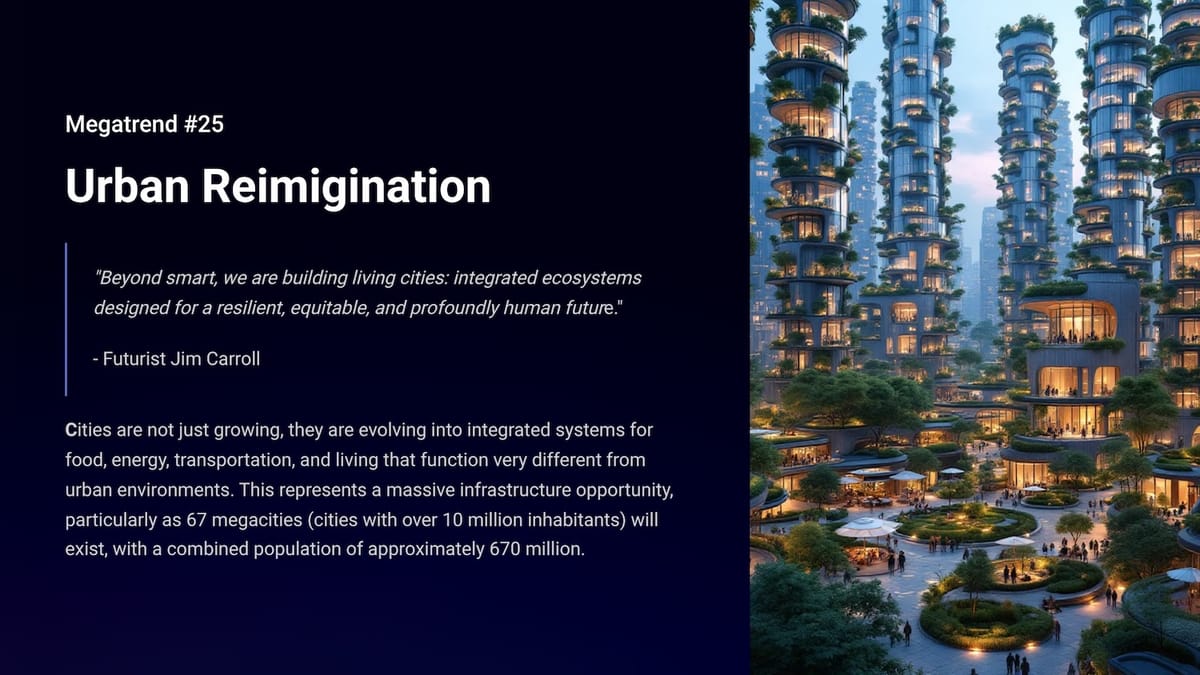"Beyond smart, we are building living cities: integrated ecosystems designed for a resilient, equitable, and profoundly human future." - Futurist Jim Carroll
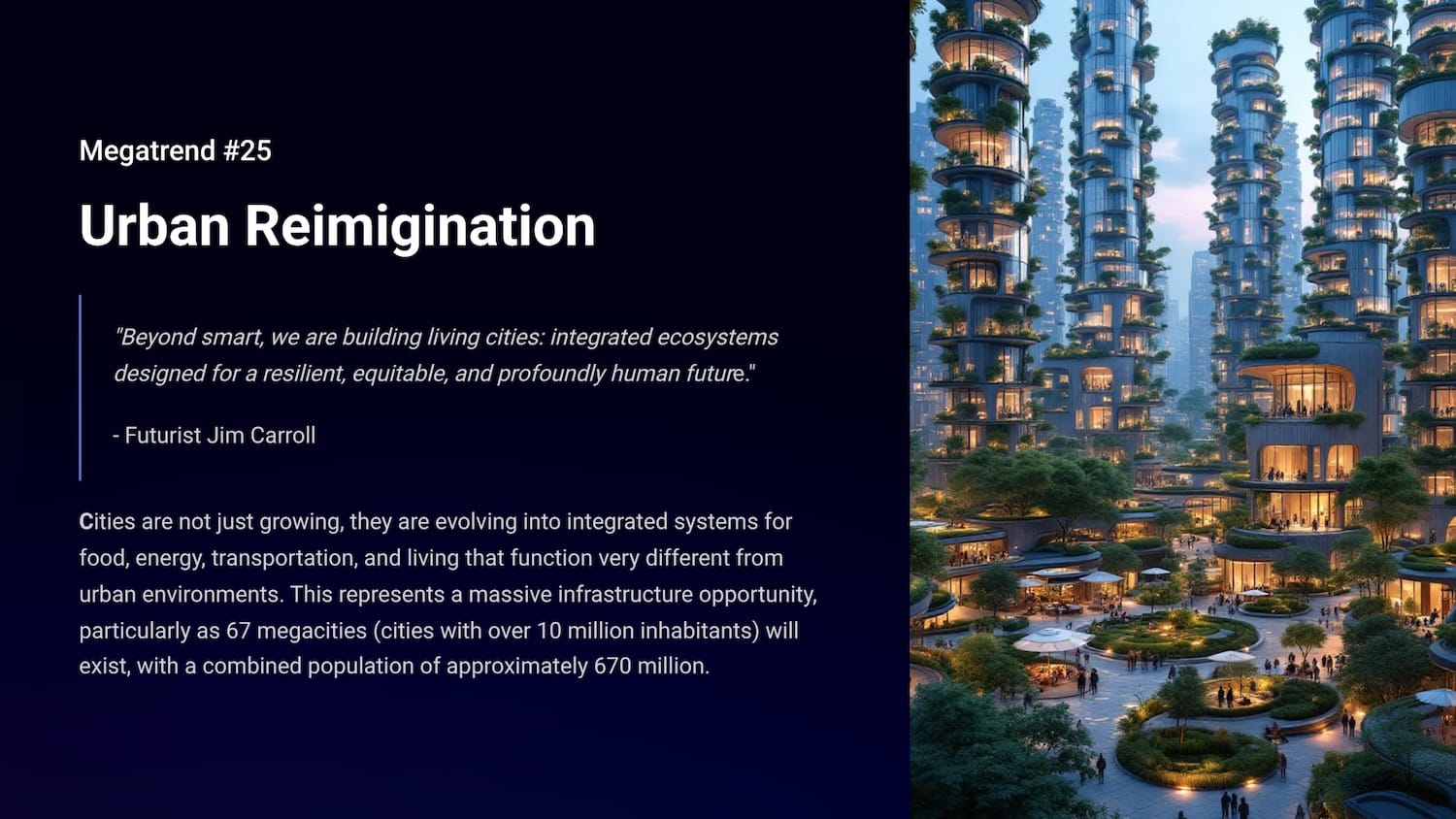
(Futurist Jim Carroll is writing a series on 30 Megatrends, which he first outlined in his book Dancing in the Rain: How Bold Leaders Grow Stronger in Stormy Times. The trends were shared in the book as a way of demonstrating that, despite any period of economic volatility, there is always long-term opportunity to be found. The book is now in print - learn more at dancing.jimcarroll.com)
Cities are not just growing, they are evolving into integrated systems for food, energy, transportation, and living that function very differently from urban environments. This represents a massive infrastructure opportunity, particularly as 67 megacities (cities with over 10 million inhabitants) will exist, with a combined population of approximately 670 million. It's called the "integrated city", and it's a pretty significant transformation of what we think of as urban areas.
Let's dig in - to start, here's the full PDF report.
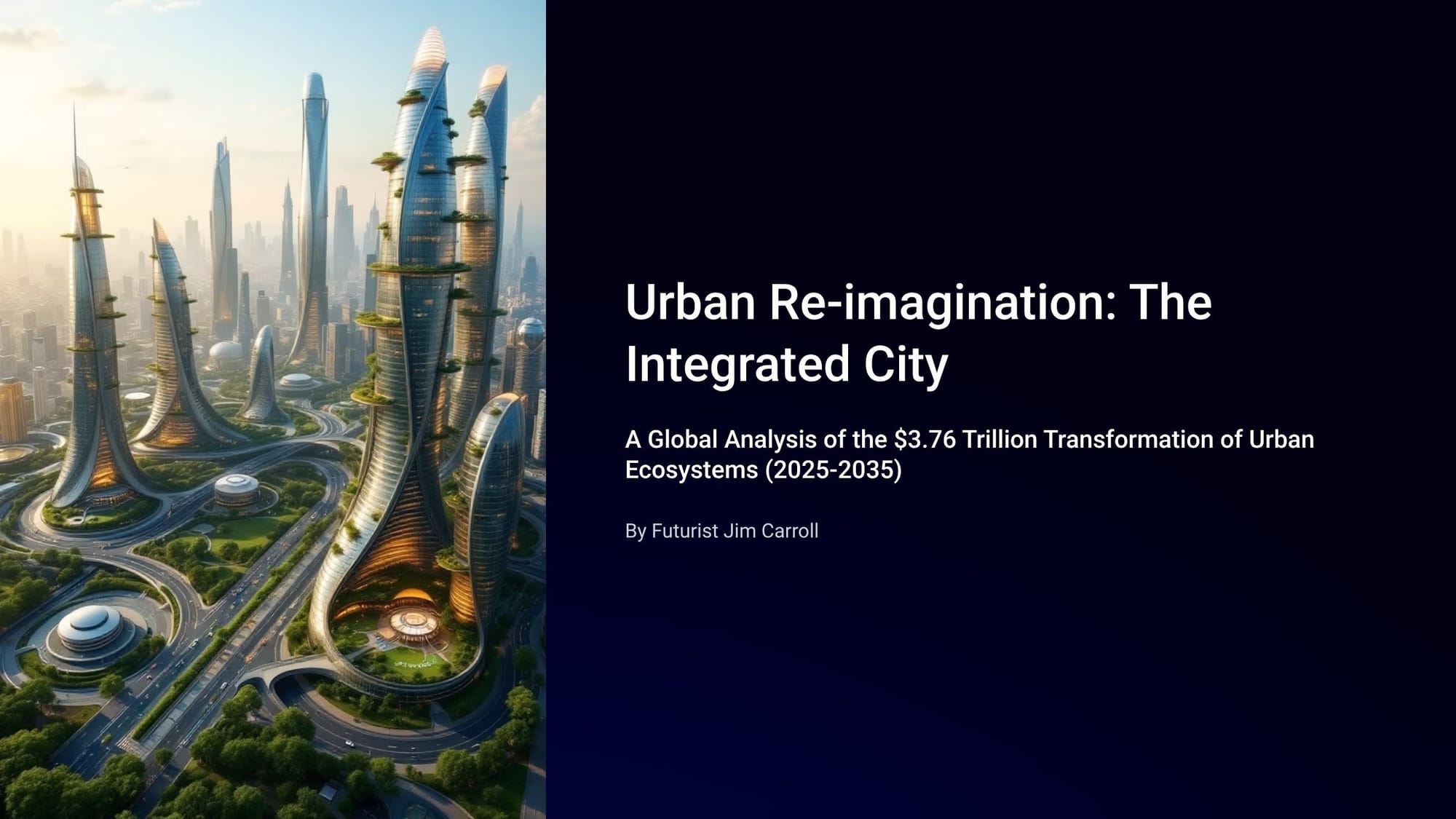
What's it all about? Cities worldwide are undergoing their most profound transformation since the Industrial Revolution. This is not merely about making cities “smarter” with technology, but about a fundamental rethinking of the entire concept and layout of a city. It's not just about a bunch of smart technology, but a complete rethinking of systems for food, energy, transportation, and living. By 2035, this shift will redefine urban life, particularly as the world accommodates 67 megacities housing a combined 670 million people.
And it's a HUGE megatrend infrastructure opportunity, creating a market projected to reach $3.76 trillion by 2030.
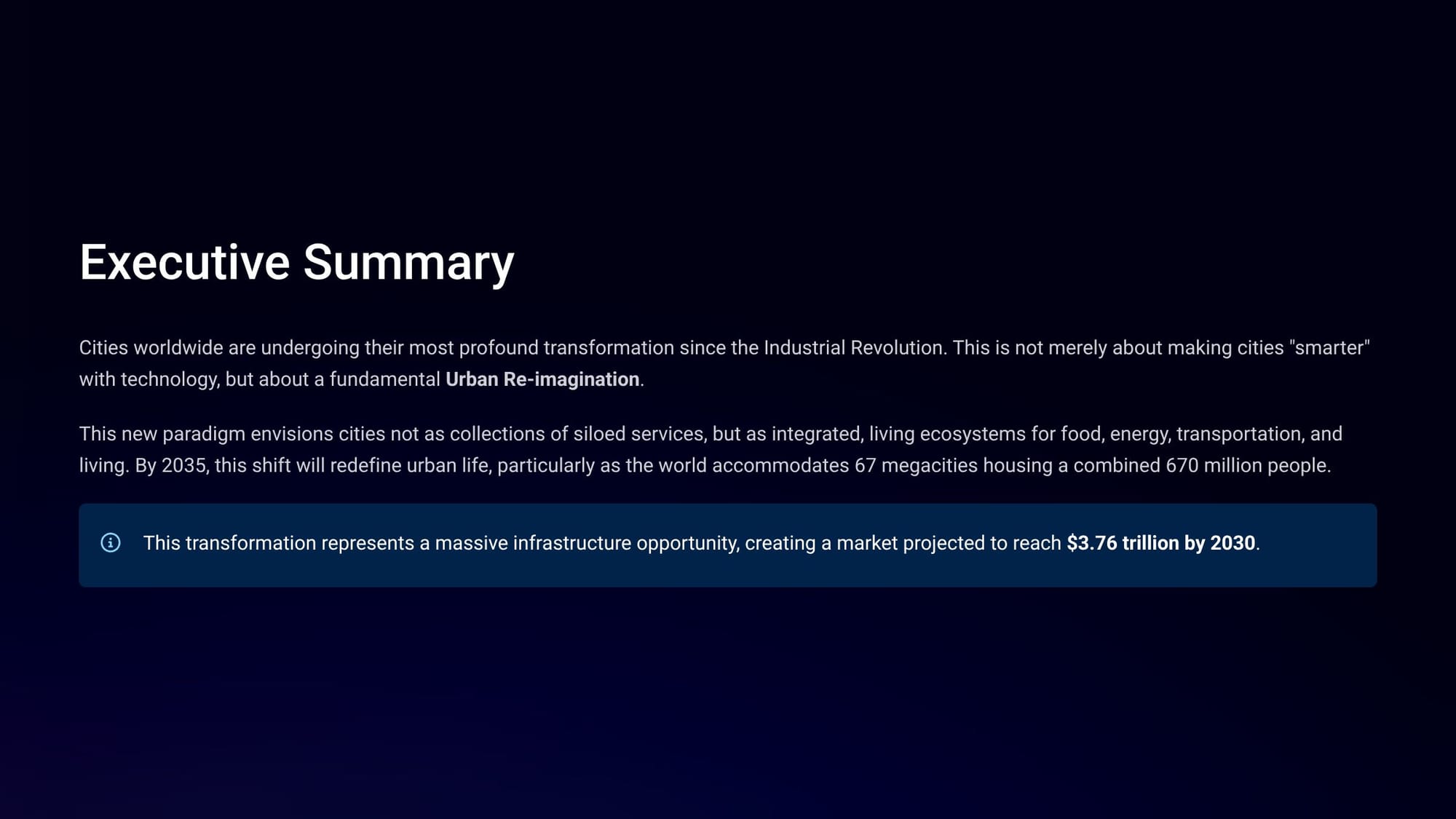
Part of the reason for the trend is that simply, we simply need to rethink how cities function in light of scarce resources. Cities consume 75% of extracted natural resources and generate up to 80% of greenhouse gas emissions, making a transition from linear ‘take-make-waste’ models to circular resource flows an imperative for survival.
The scientific foundations for this shift are now well-established, with research from institutions like MIT’s Senseable City Lab and LSE Cities confirming that new ways of thinking can yield 10-90% improvements in resource utilization.
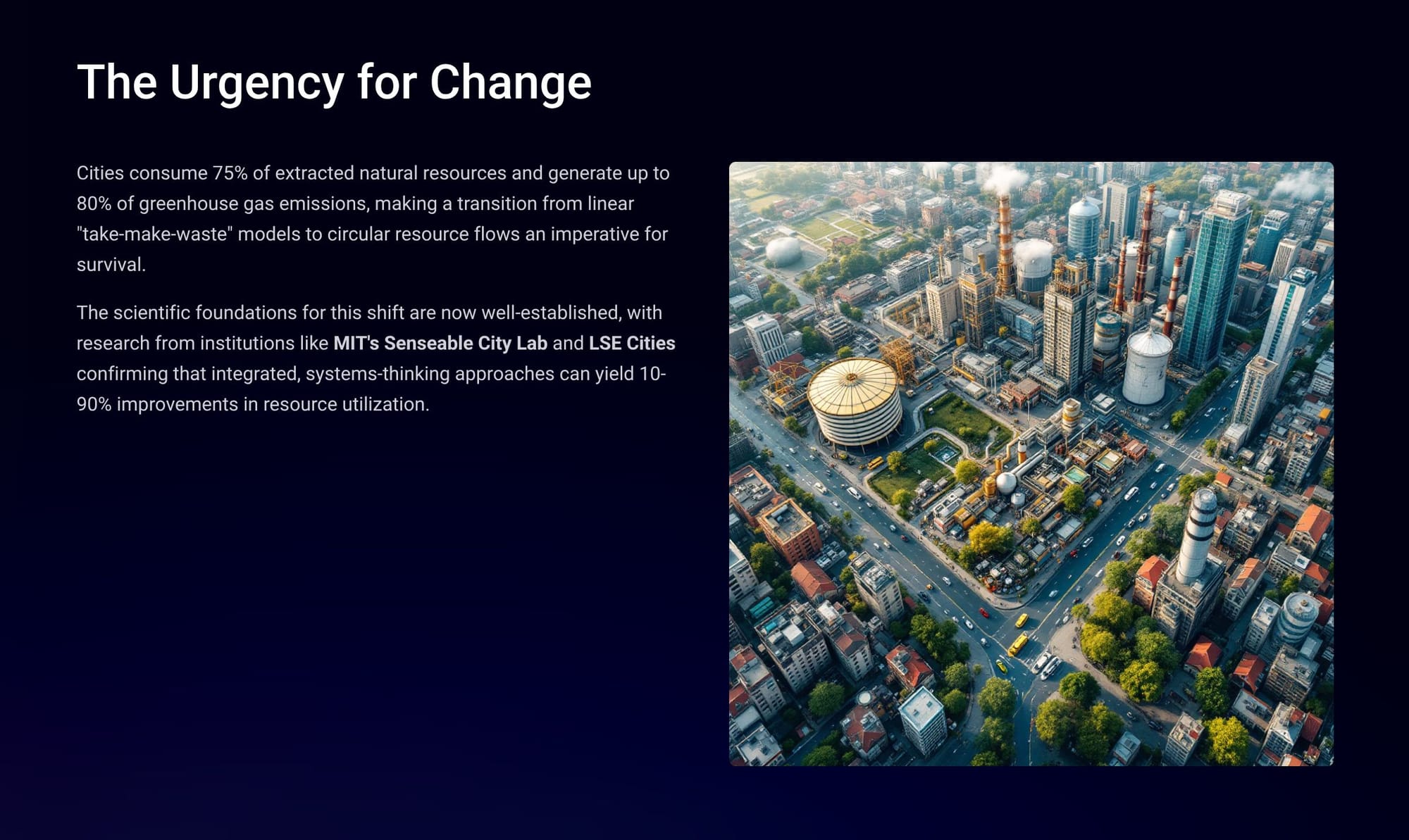
It's not just that - it's the rise of the megacities that is driving this trend. The global urban population is projected to grow from 4.8 billion today to 5.6 billion by 2035. However, this growth is not uniform; it is characterized by profound regional divergence.
- 47 Megacities by 2030. Up from 37 today, with Delhi projected to become the world's most populous urban agglomeration by 2028.
- 3.1% Annual Growth in Sub-Saharan Africa. The world's fastest-urbanizing region, with a deeply youthful population (60% under 25).
- 30% Rural-to-Urban Migration. Now accounts for only this percentage of urban growth in Asia-Pacific, with natural increase and reclassification becoming dominant drivers.
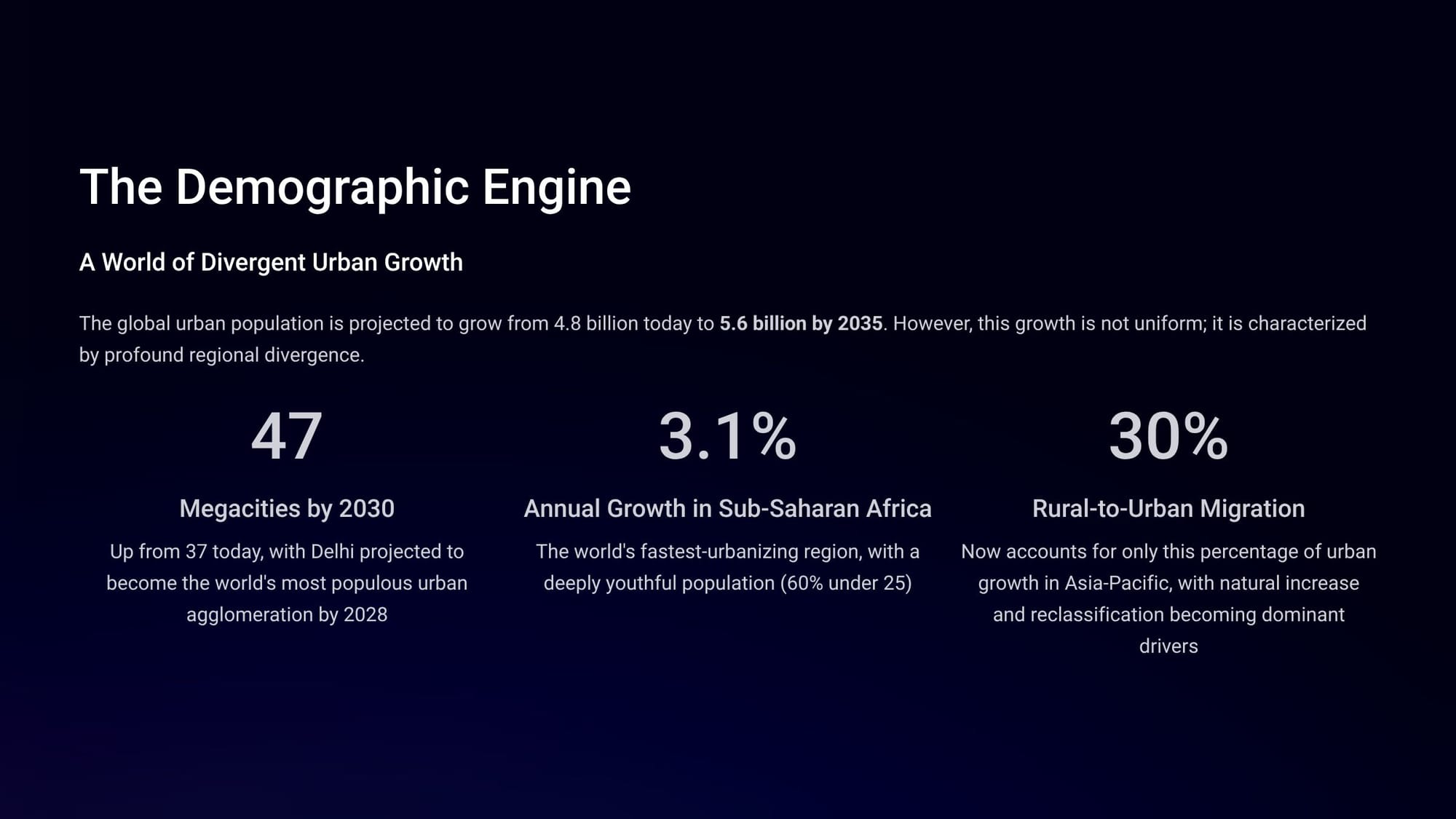
Add to this the fact that experience is showing some very real generational preferences when it comes to cities and urban areas. Millennials show a preference for dense, walkable urban cores with mixed-use developments and access to public transportation. Generation Z? The most urbanized generation expects tech-enabled city living with seamless digital services and sustainable infrastructure - something that matches the overall tech-enabled world that they live in.
This complex demographic landscape means there is no one-size-fits-all model for urban development. A city in Africa with a young, rapidly growing population has fundamentally different needs from an aging megacity in Europe.
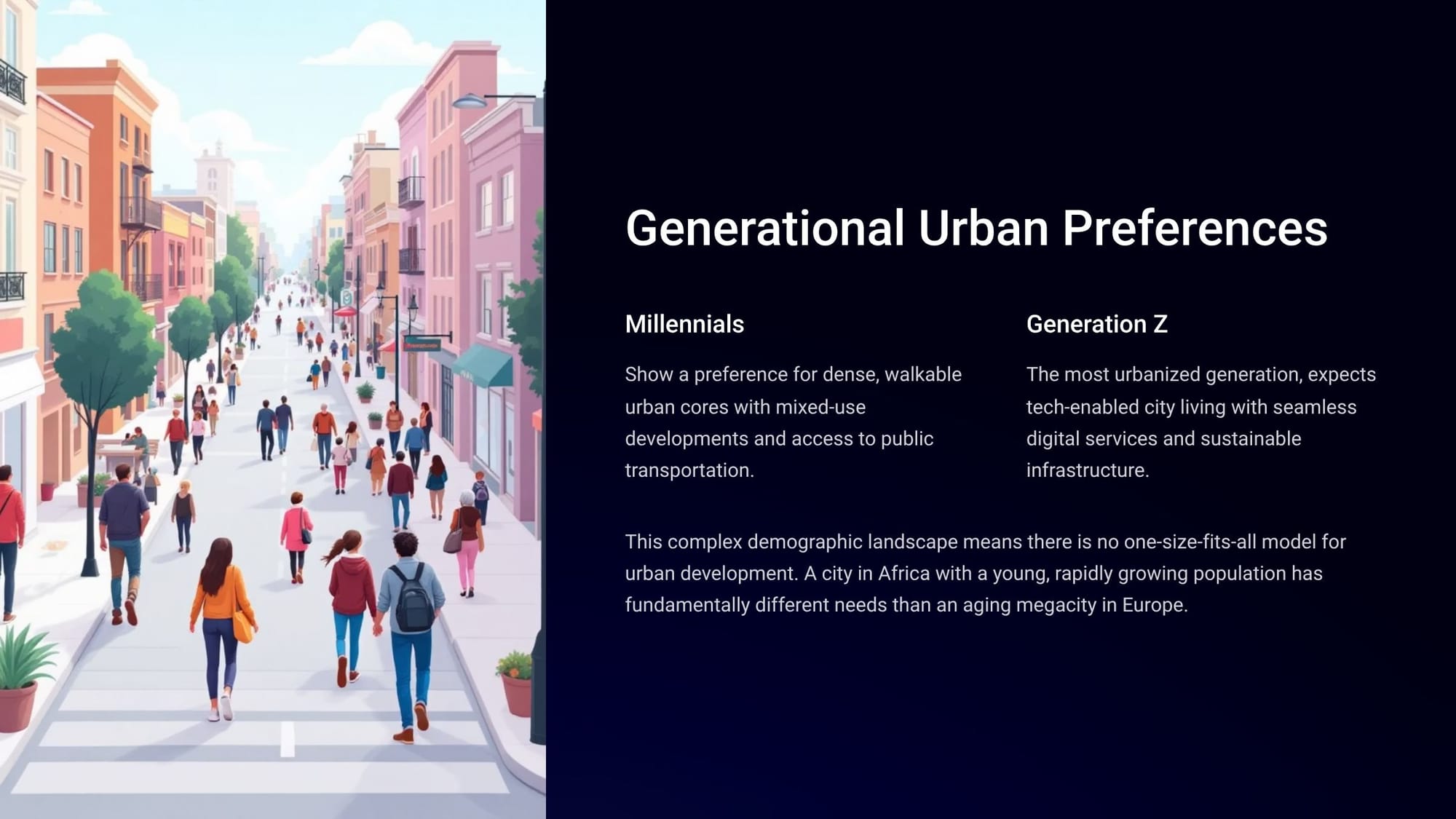
The technological backbone for this re-imagination is, of course, new technologies. And guess what - it's the same trifecta that is driving so many other megatrends in this series!
- IoT Sensor Network. A foundational layer of IoT sensors, powered by 5G networks, acts as a city’s nervous system, collecting real-time data across all urban systems.
- AI-Driven Analytics. This data feeds into AI-driven analytical platforms that process information and enable predictive management of urban resources.
- Digital Twins. Virtual city models are used for real-time management that functions as an “Urban Operating System,” simulating scenarios and optimizing operations.
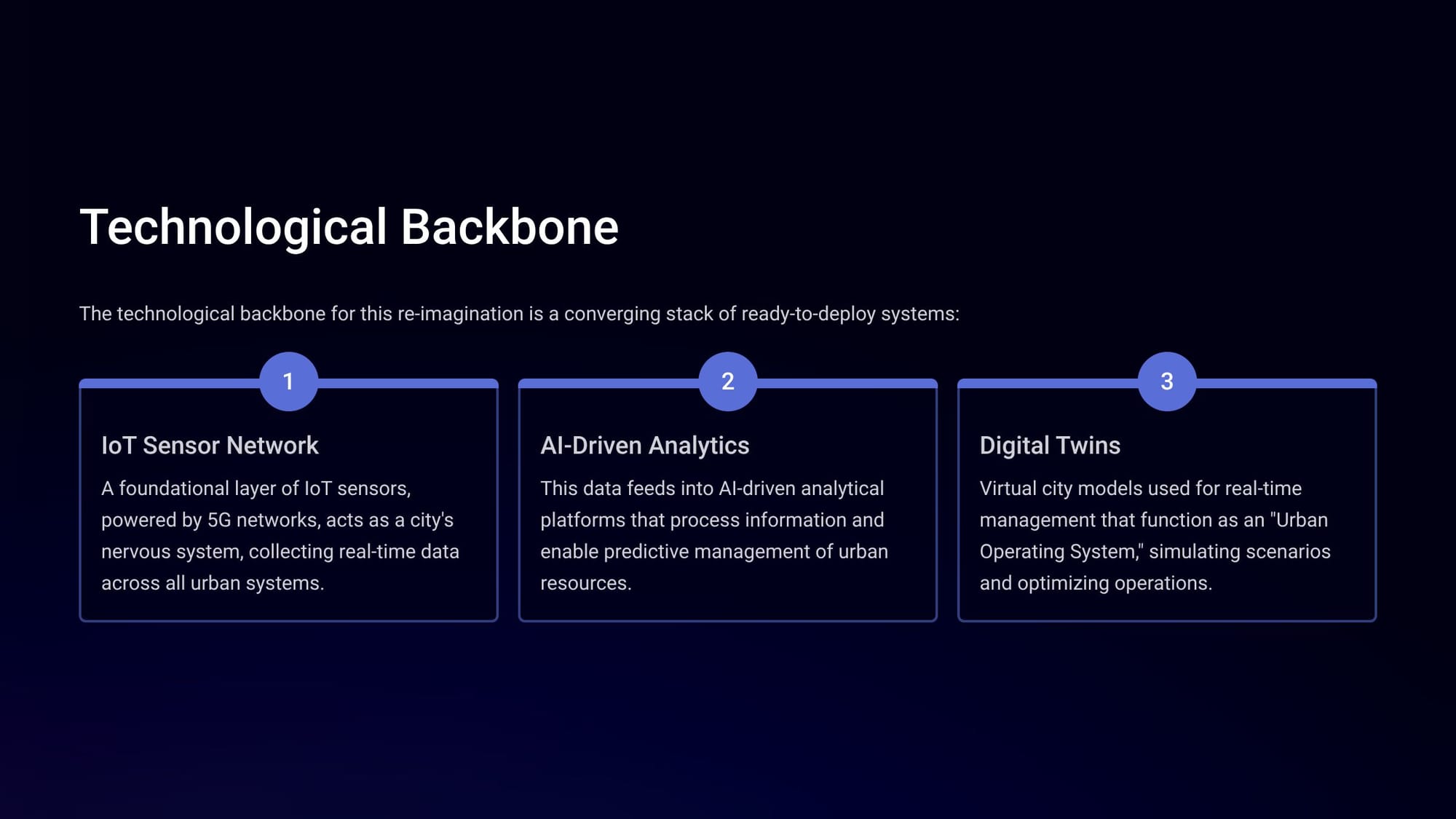
These technologies bring about several new ideas that help us to reimagine the architecture of a city:
- Resilient Energy. Decentralized microgrids and smart grid architectures, backed by a planned €584 billion EU investment by 2030, are integrating renewables and ensuring energy security.
- Intelligent Mobility. Mobility-as-a-Service (MaaS) platforms are unifying transport options, while the transition toward autonomous public transit and even hyperloop systems begins.
- Circular Metabolism. Urban agriculture, through technologies like vertical farming and aquaponics, is re-localizing food production, while circular economy models are transforming waste streams into valuable resources.
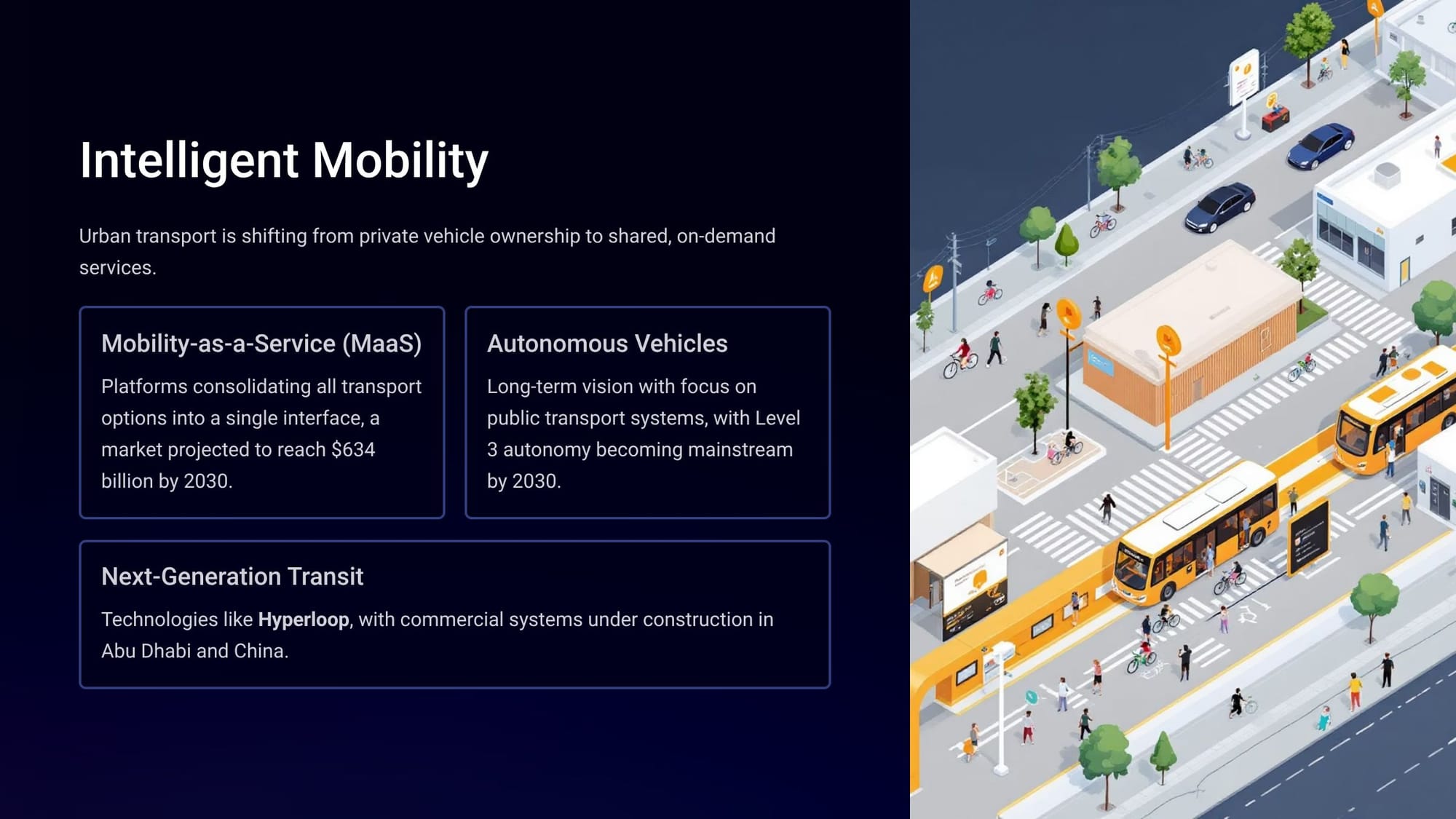
There are huge technological opportunities behind all this - let's come back to each of the three items in the trifecta
- IoT Sensory Layer. 5 billion devices projected by 2028, connected by high-speed 5G networks.
- Data Streams. Vast amounts of real-time information about all urban systems.
- AI-Powered Analytics. Enables shift from reactive problem-solving to proactive, predictive governance.
- Digital Twin Integration. High-fidelity virtual city models for monitoring, analytics, and planning.
This presents some unique opportunities. For example, the urban energy grid is being redesigned for resilience and sustainability. The focus is on decentralized microgrids, which can operate autonomously during blackouts.
- $20.7B 2024 Microgrid Market
- $89.7B 2033 Projection
This is supported by massive investment in smart grid architecture: the EU plans a €584 billion investment by 2030, and China is committing $442 billion through 2025.
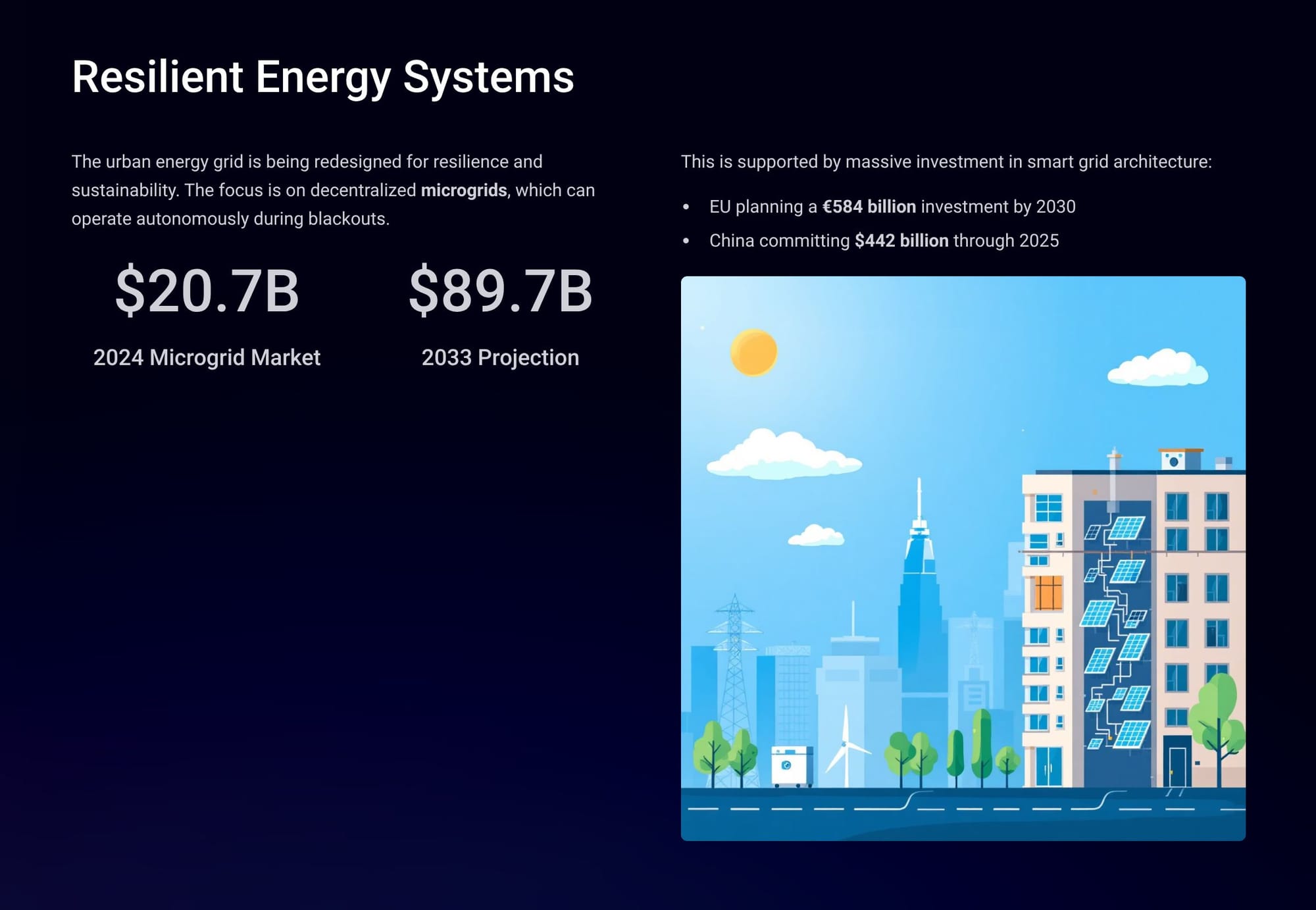
One of the trends to watch is the idea of "intelligent mobility." Urban transport is shifting from private vehicle ownership to shared, on-demand services.
- Mobility-as-a-Service (MaaS). Platforms consolidating all transport options into a single interface, a market projected to reach $634 billion by 2030.
- Autonomous Vehicles. Long-term vision with a focus on public transport systems, with Level 3 autonomy becoming mainstream by 2030.
- Next-Generation Transit. Technologies like the Hyperloop, with commercial systems under construction in Abu Dhabi and China.
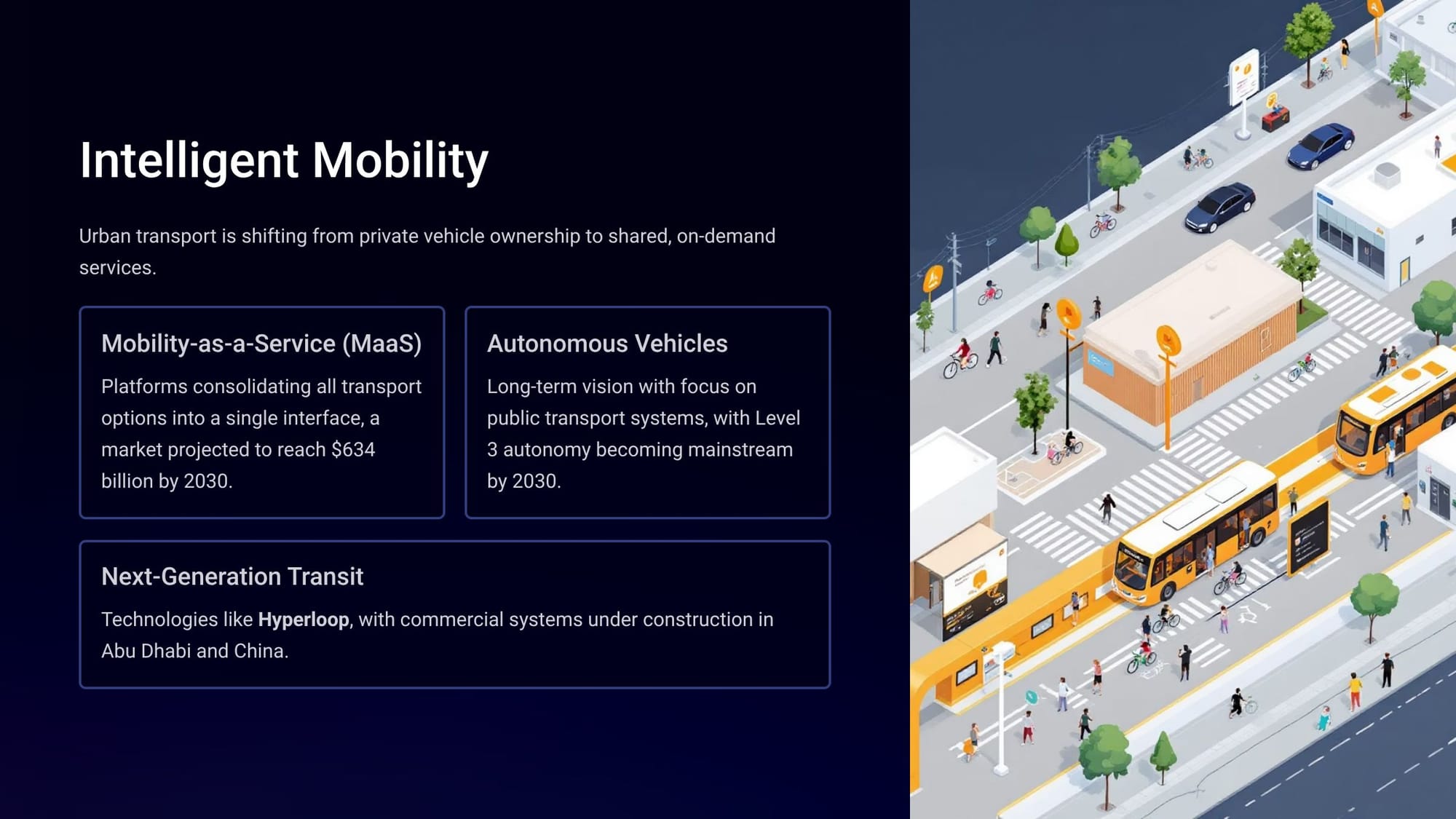
Then there is the arrival of intelligent buildings & infrastructure. The market for building automation is set to grow from $90.2 billion in 2023 to $152.4 billion by 2028, with AI integration driving optimization.
- Advanced materials are transforming infrastructure:
- Self-healing concrete that repairs cracks automatically
- Photovoltaic coatings that generate energy from building surfaces
- Smart materials that respond to environmental conditions
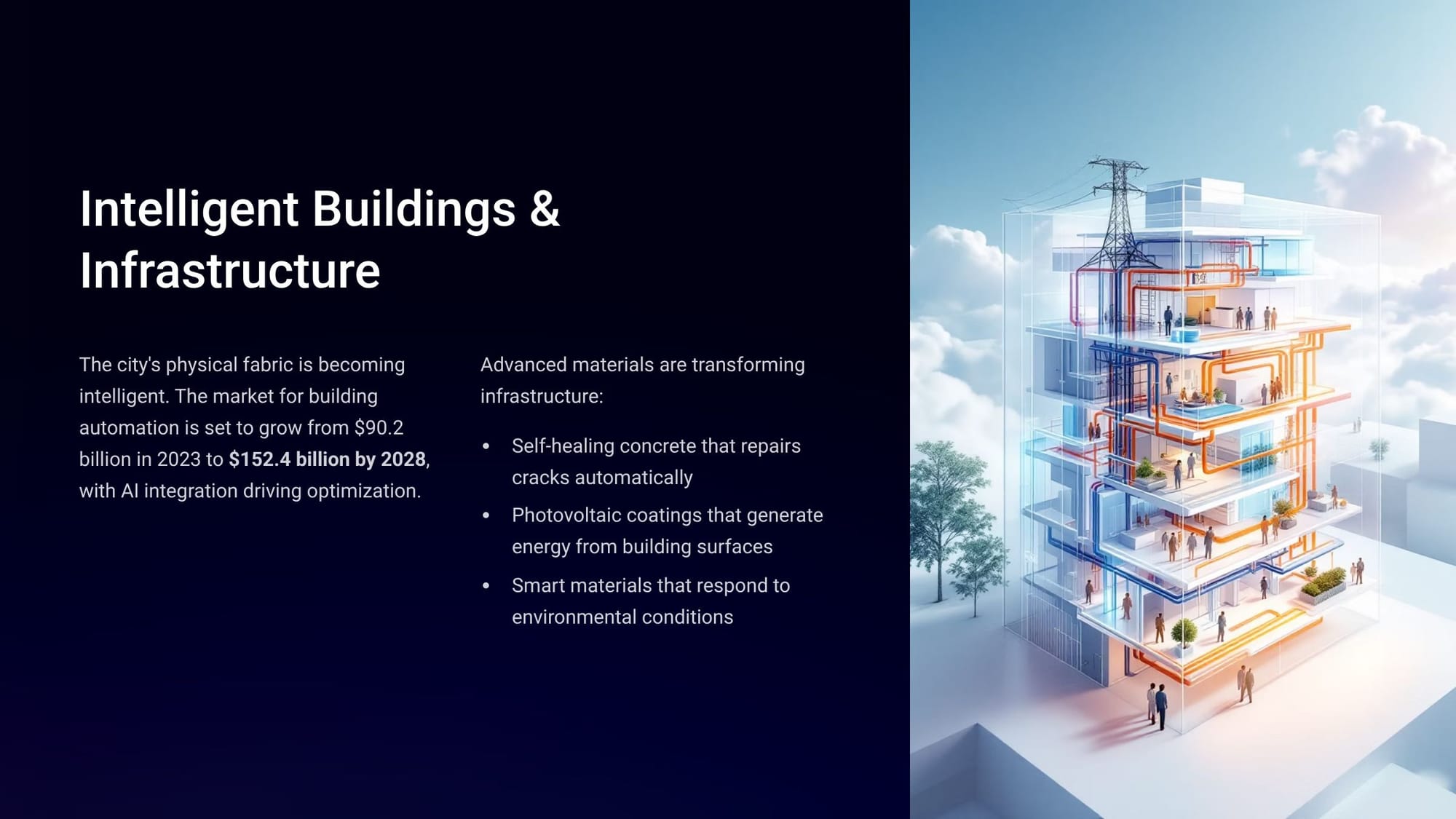
Or how about urban food production via vertical farms? To enhance food security, cities are embracing high-tech urban agriculture. The vertical farming market is projected to reach $35.76 billion by 2032, with systems that can produce 10 times more crops using 90% less water!
Aquaponics, which integrates fish and plant cultivation, offers a pesticide-free, closed-loop system. Companies like Traders Hill Farm and Edenworks are already demonstrating commercial-scale viability, supplying major urban retailers.
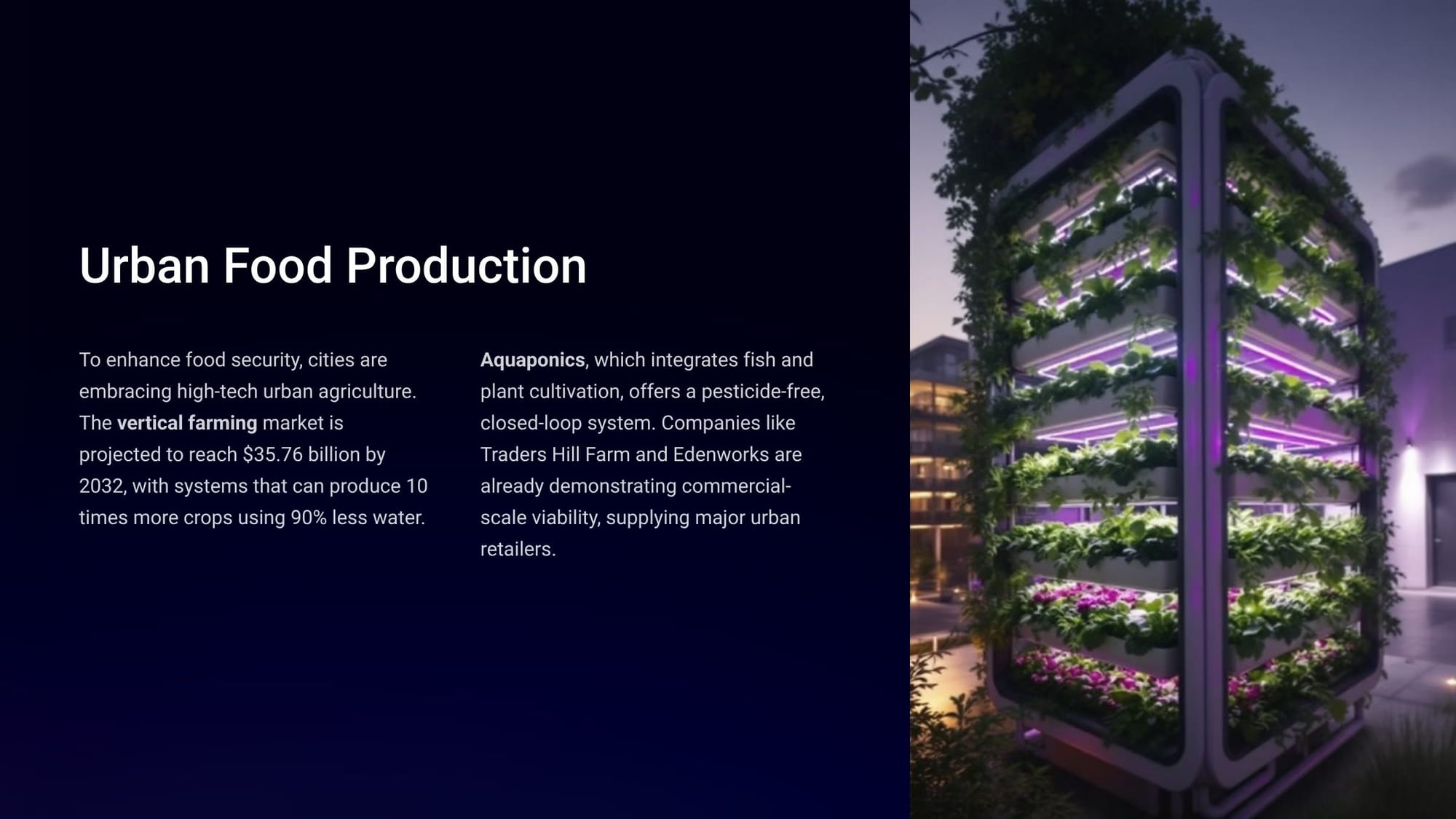
Or how about the "15-Minute City" concept - it's a powerful model for human-centric design. It aims to ensure residents can access all daily necessities within a 15-minute walk or bike ride, improving quality of life by reducing car dependency. Cities from Paris to Shanghai are adopting this model to create more livable, sustainable urban environments.
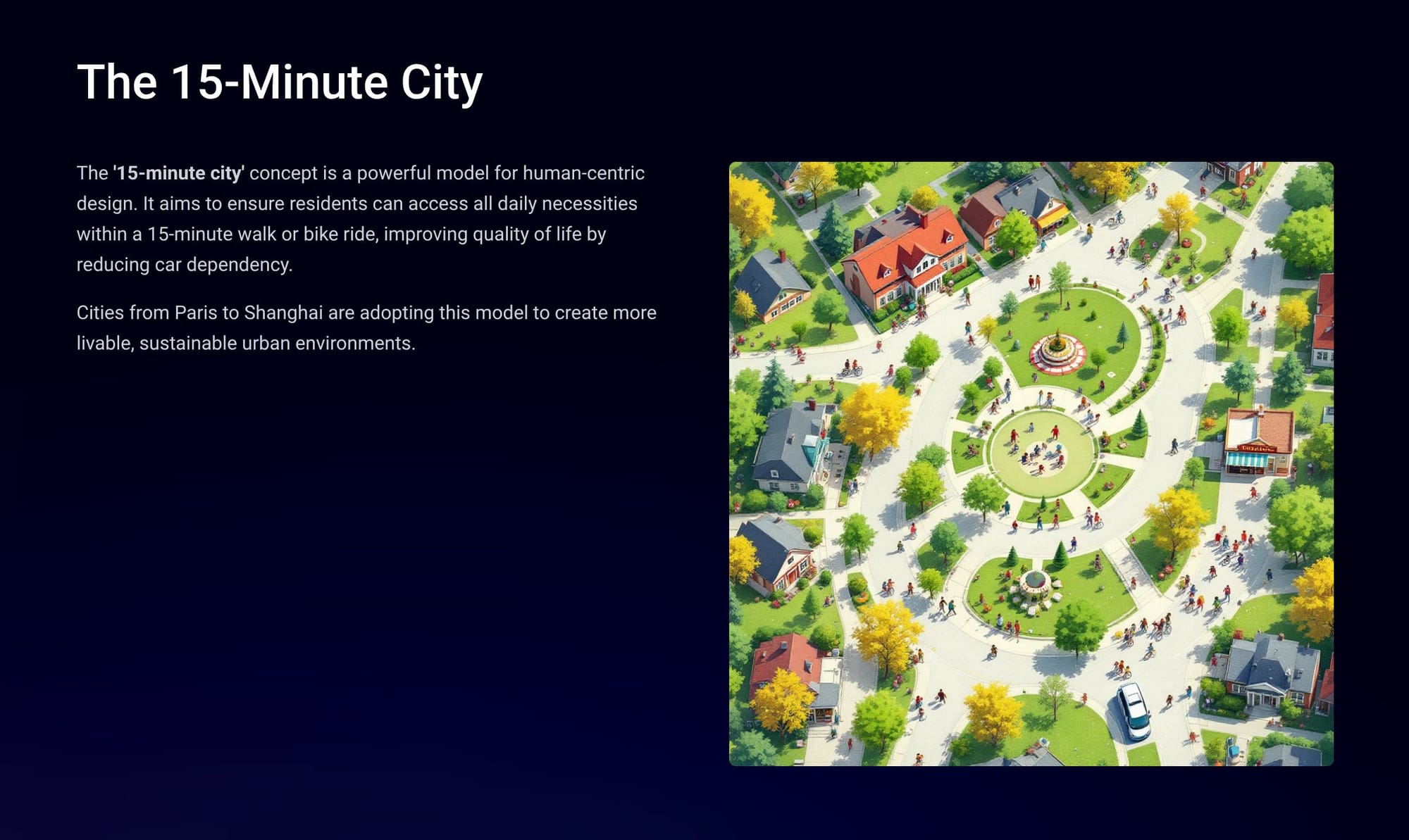
Looking forward, there are several breakthrough technologies identified by MIT Technology Review for 2025 are already entering the urban landscape.
- Commercially Available Robotaxis. Autonomous vehicles are providing on-demand transportation services in geo-fenced urban areas.
- Fast-Learning Robots. Adaptable robots for urban environments that can learn new tasks and navigate complex city spaces.
- Green Steel Production. Low-carbon steel manufacturing to reduce construction emissions in urban development.
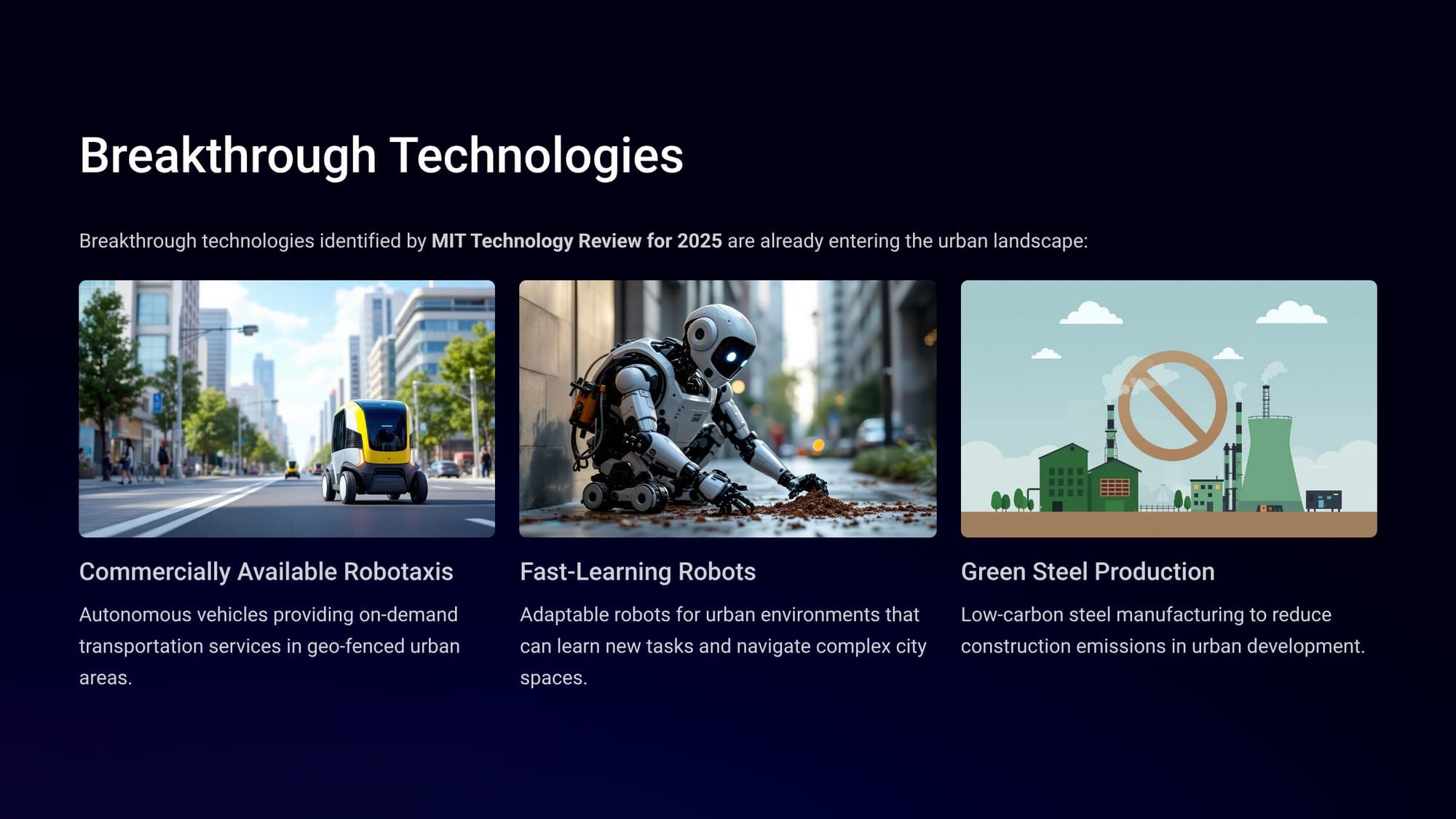
The interesting thing is that while all of this is evolving globally, it's happening with very different ideas and priorities in mind. What's also important to note is that most of the innovation is occurring outside of North America, an interesting trend as the US abandons its traditional role in global innovation leadership.
Here's an overview of some of the regional activities.
Asia: Technology-Driven Megacities
Asia emphasizes technology-driven, state-led megacity solutions, as exemplified by Singapore’s "Smart Nation" initiative. The region is home to the world’s fastest-growing urban populations and is pioneering large-scale smart city implementations with strong government direction.
Key characteristics:
- Centralized planning and implementation
- Heavy investment in digital infrastructure
- Integration of surveillance and management systems
- Focus on efficiency and technological solutions
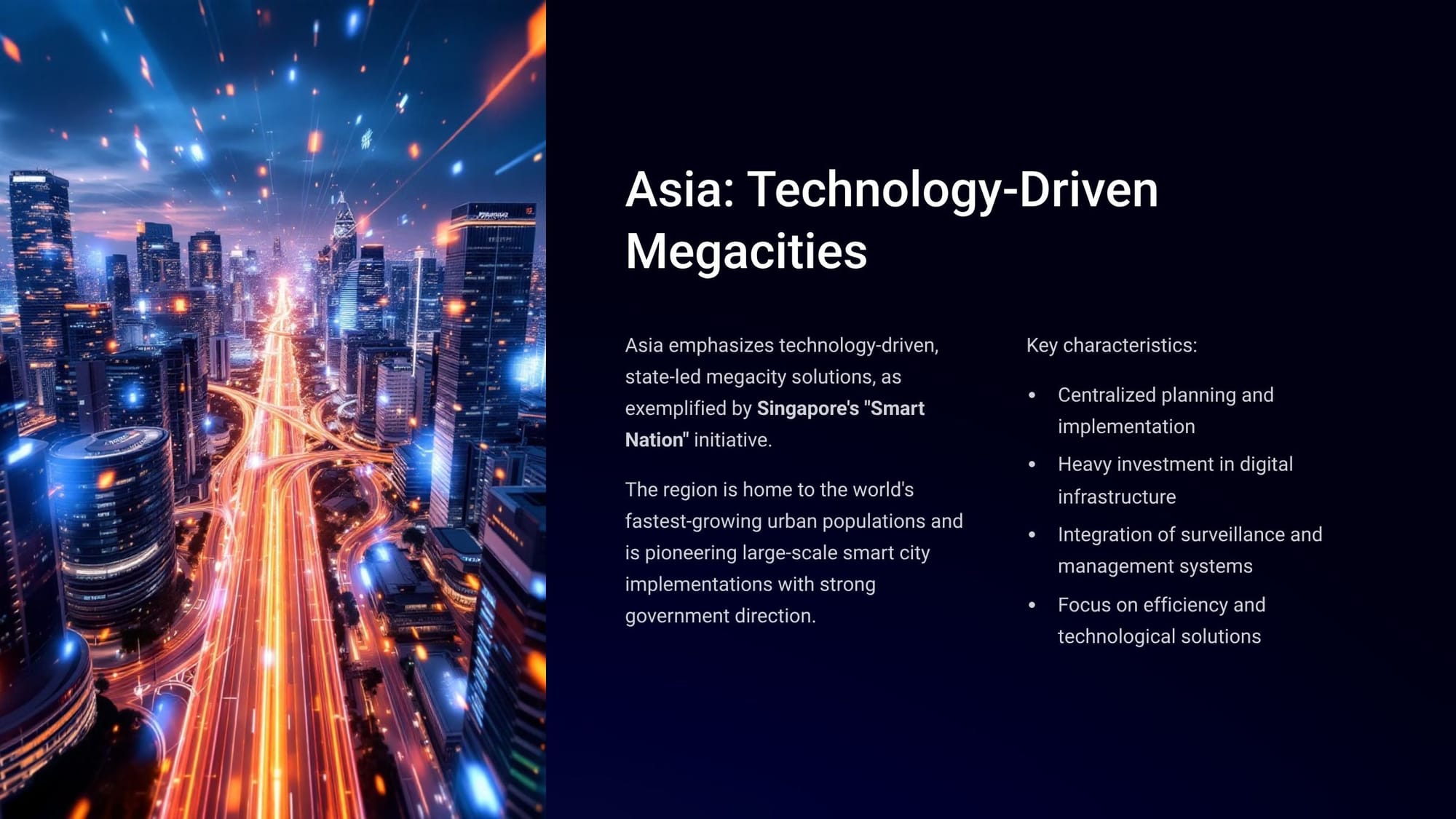
Africa: Managing Rapid Urbanization
Africa focuses on master planning and infrastructure development to manage the world’s fastest rate of urbanization, blending formal plans with the reality of informal systems.
Key characteristics:
- Leapfrogging traditional infrastructure with mobile solutions
- Addressing basic service needs alongside digital innovation
- Incorporating informal economies into formal planning
- Developing resilience to climate impacts
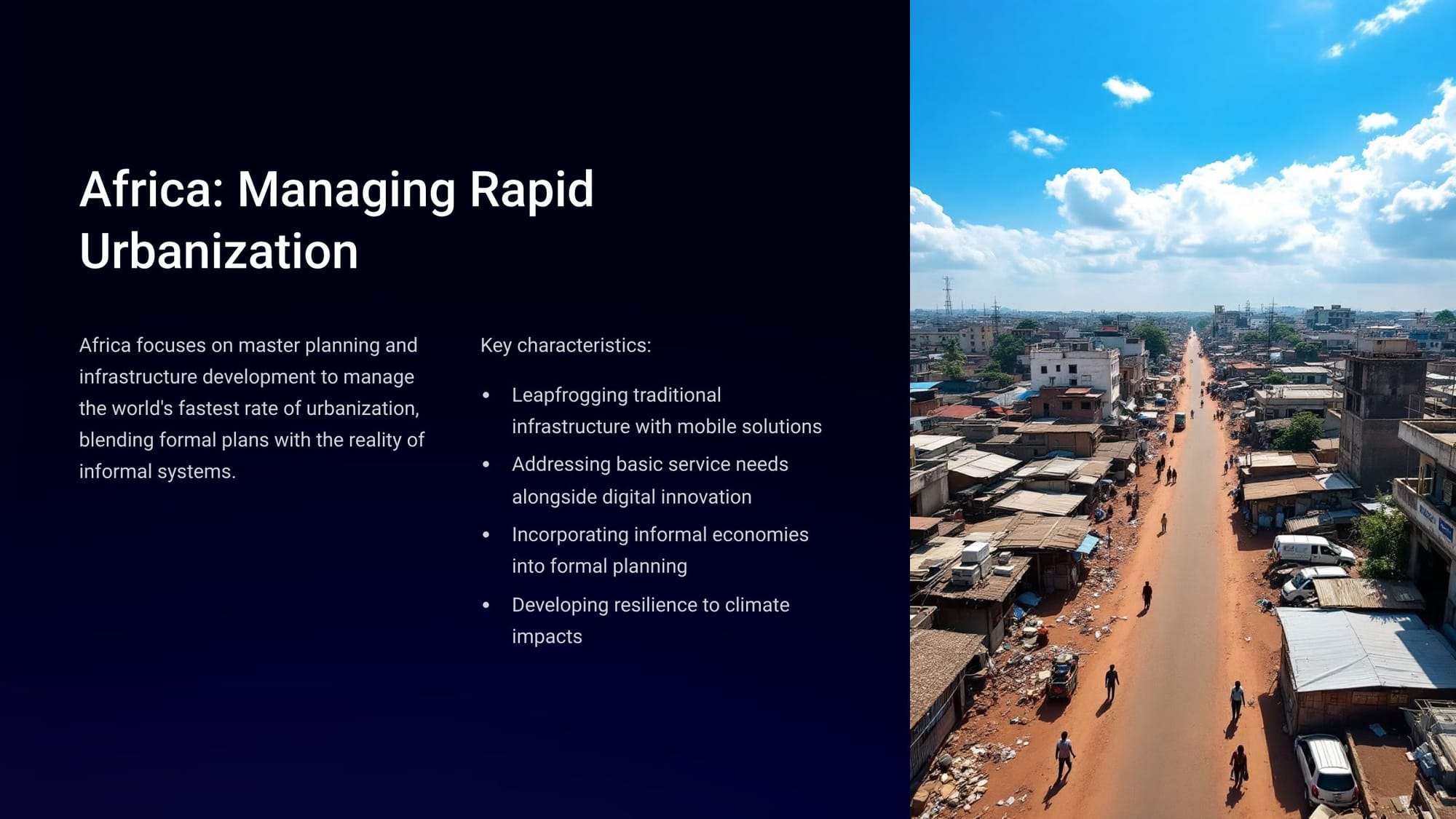
Latin America: Social Urbanism
Latin America pioneers social urbanism, prioritizing equity and public space, as seen in Medellín and Curitiba’s world-renowned Bus Rapid Transit.
Key characteristics:
- Focus on social inclusion and reducing inequality
- Innovative public transportation solutions
- Integration of informal settlements
- Participatory planning processes
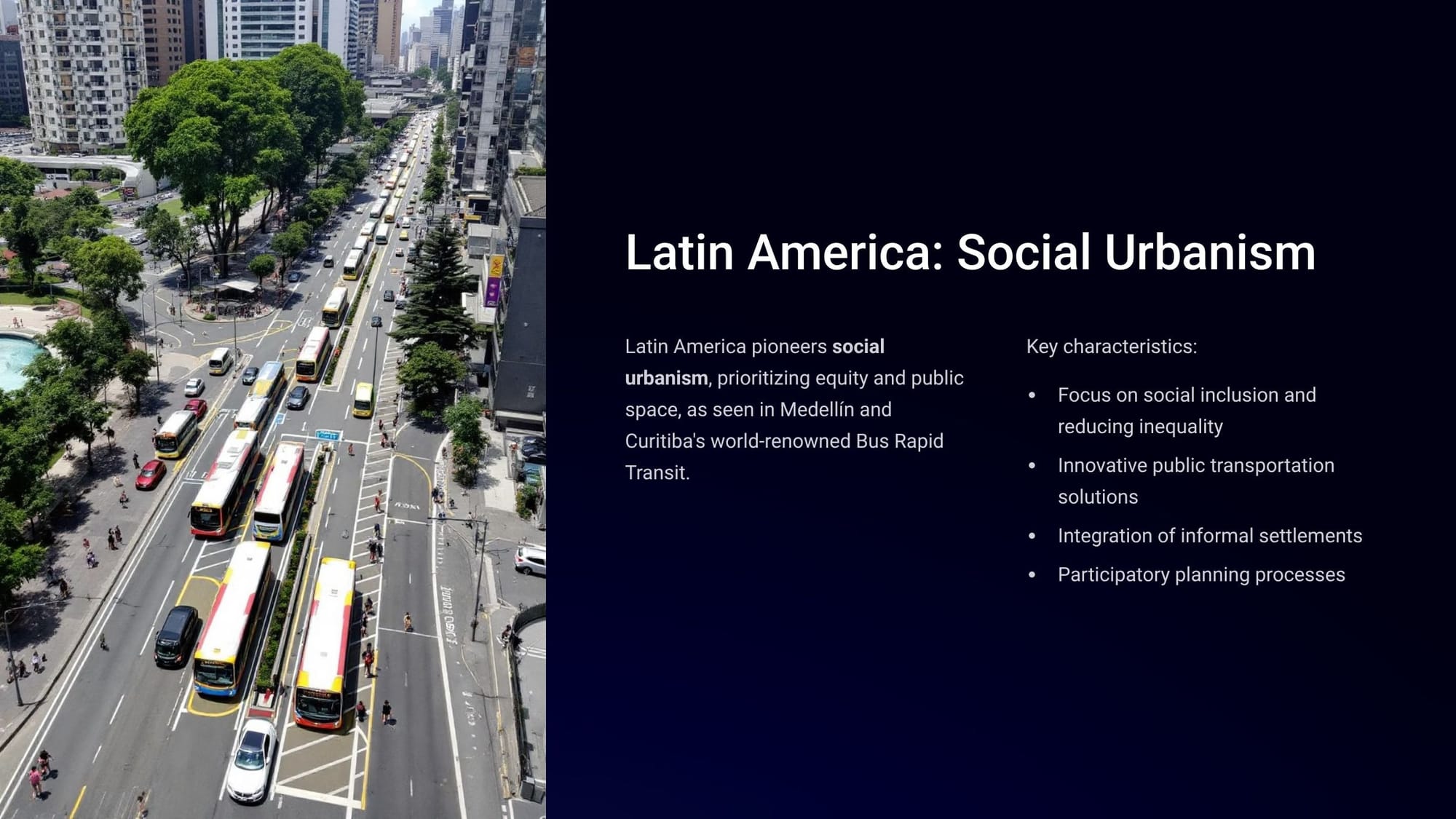
Europe: Sustainable Regeneration
Europe leads on sustainability and participatory regeneration in mature cities, with a policy-driven focus on the circular economy and climate action.
Key characteristics:
- Retrofitting historic urban fabric with smart technologies
- Strong regulatory frameworks for sustainability
- Citizen-led innovation and co-creation
- Focus on quality of life and cultural preservation
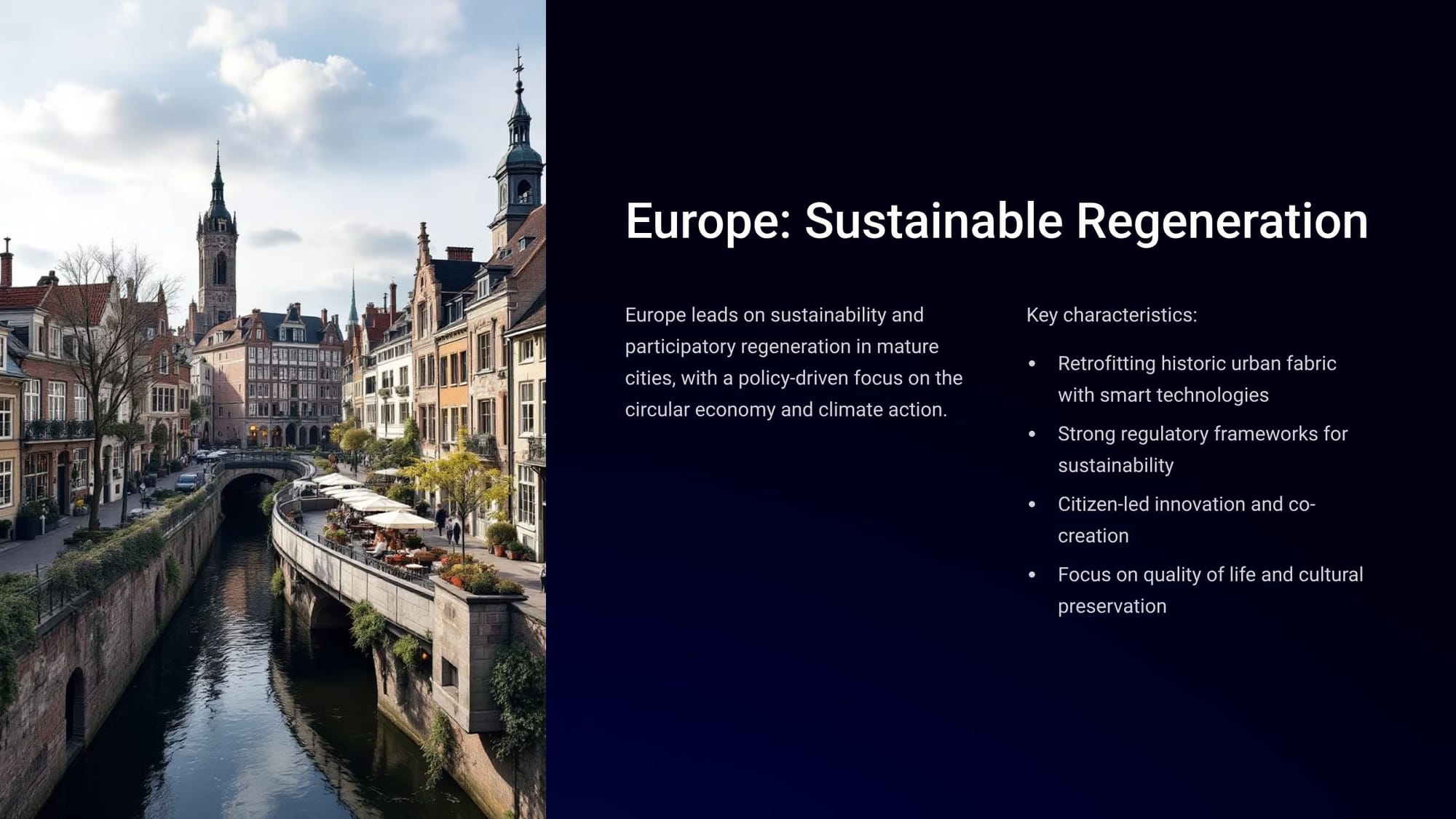
Oceania: Indigenous Knowledge Integration
Oceania integrates indigenous knowledge systems with Western planning, emphasizing nature-based solutions and biodiversity.
Key characteristics:
- Recognition of traditional land management practices
- Focus on coastal resilience and climate adaptation
- Integration of natural systems into urban planning
- Collaborative governance models with indigenous communities
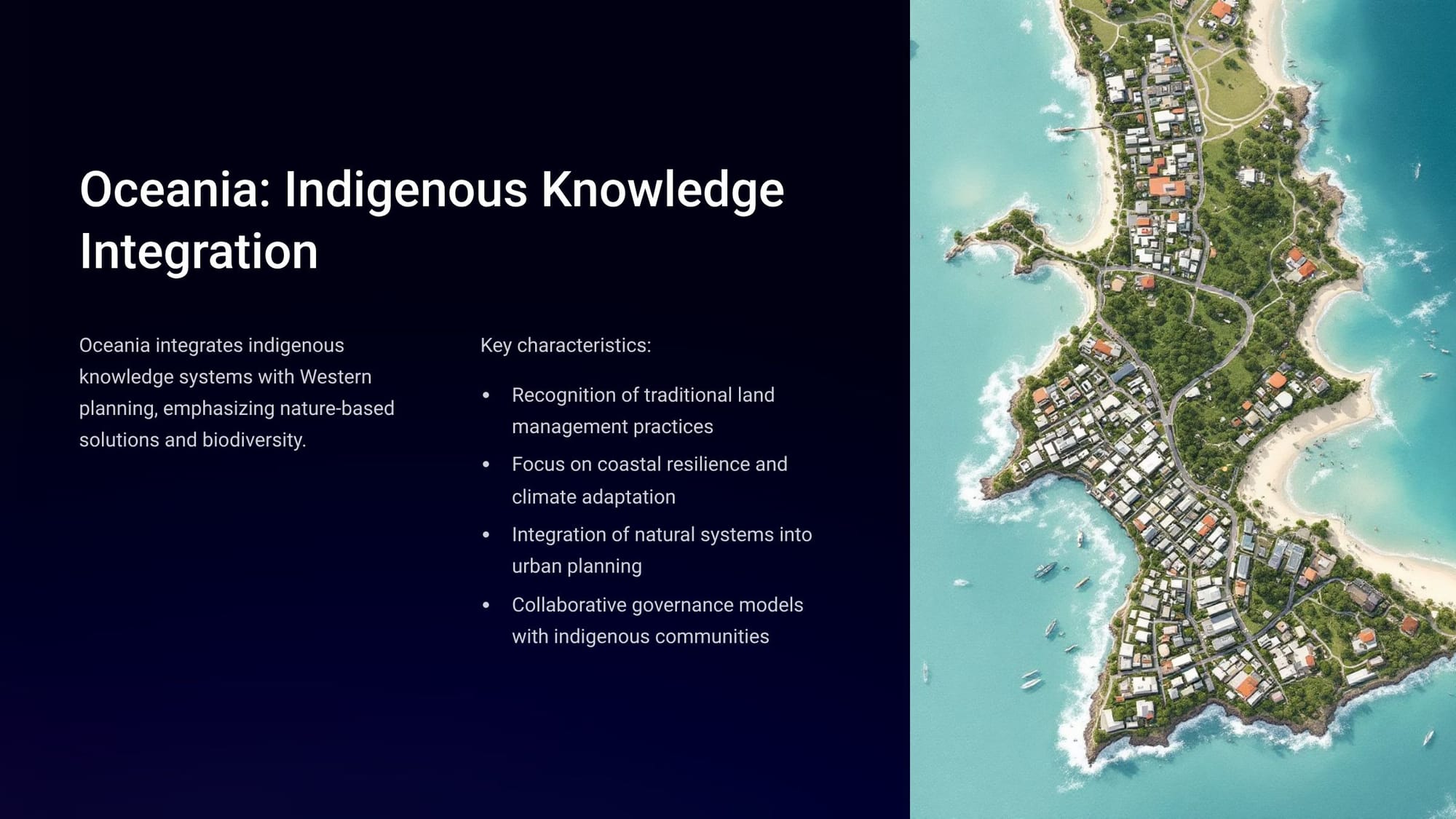
As a megatrend, the opportunities are significant. The decade ahead will determine whether cities become integrated systems that enhance human potential or fragmented environments that exacerbate existing challenges. Success requires unprecedented cooperation, sustained investment, and an unwavering commitment to human-centered urban development on a global scale.
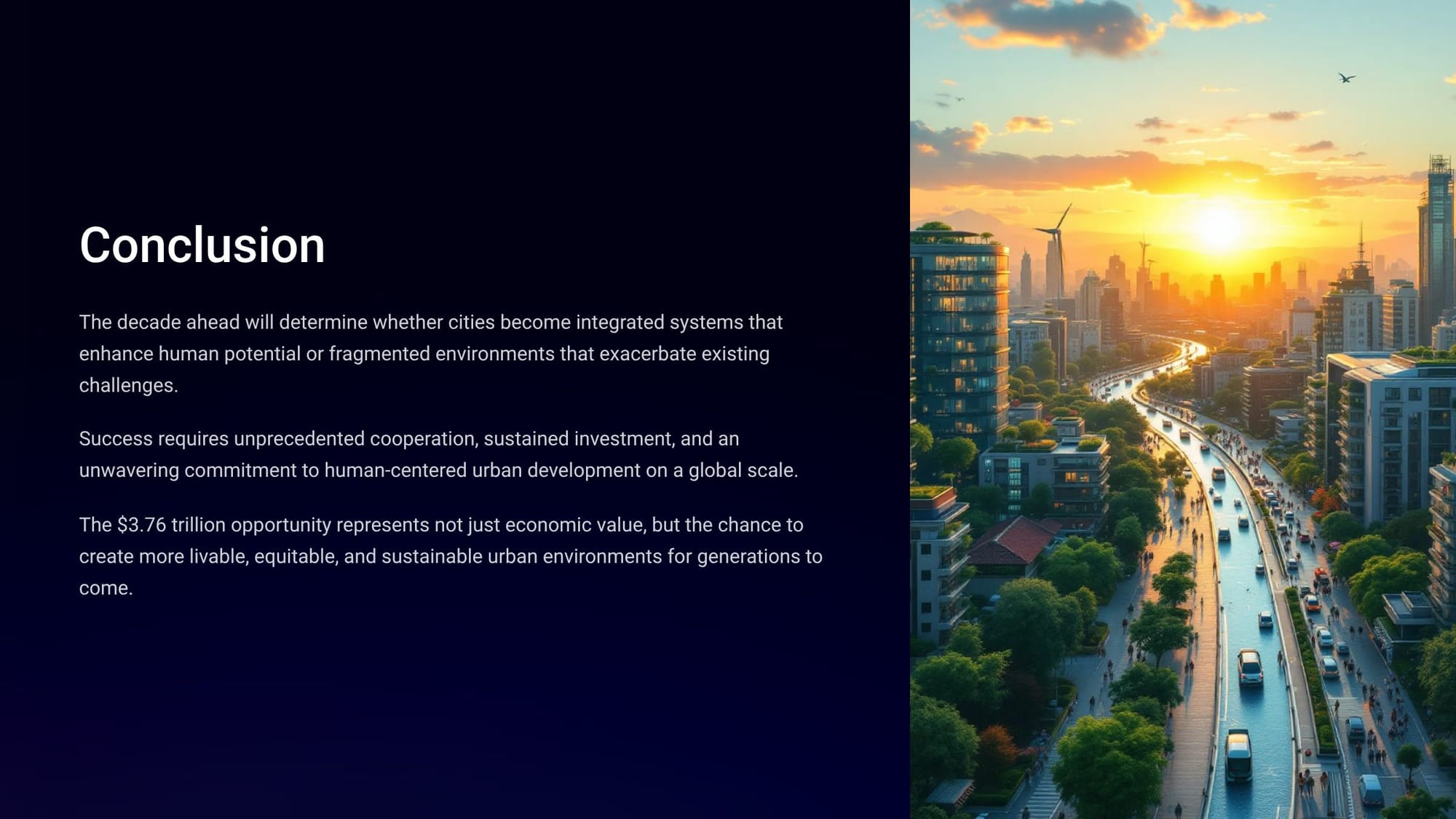
But overall, the fact is this: the $3.76 trillion opportunity represents not just economic value, but the chance to create more livable, equitable, and sustainable urban environments.
Futurist Jim Carroll believes that the trifecta of IoT, AI, and digital twin technologies is one of the most powerful and yet most overlooked technology trends of our time.

